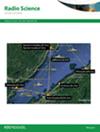Calibration of electrically short antennas using the l = 2 spherical harmonic expansion coefficients of the radio brightness distribution on the sky between 0.5 and 6.8 MHz
IF 1.5
4区 地球科学
Q3 ASTRONOMY & ASTROPHYSICS
引用次数: 0
Abstract
A space-borne radio-frequency antenna is typically located in the vicinity of a conductive spacecraft body that influences its beam. Also, at wavelengths that greatly exceed the sizes of such an antenna and spacecraft, the antenna is expected to have the beam of an equivalent short dipole. This type of beam varies with direction as sin2(ζ), where ζ is the polar angle relative to the antenna's electrical axis. We describe a Markov Chain Monte Carlo method for fitting for this axis and apply it to measurements from Parker Solar Probe's four whip antennas. Depending on how the antennas are connected to the spacecraft's radio receiver, their voltages are processed individually for “monopole” measurements or differenced for “dipole” measurements. We find with a reduced χ2 = 1.01 that the electrical axes of the dipoles deviate from the whip axes by 0° — 4°. A byproduct of this fit is a measurement of the l = 2 spherical harmonic expansion coefficients of the brightness distribution on the sky. We utilize this measurement to in turn determine the electrical axes of the monopoles from a much smaller data set. These are found to be deflected ≈ 27° away from the whips. Rheometric calibration and computational electromagnetic simulations of the antenna system corroborate the fits. All of the analyzed data were captured with the spacecraft solar array deployed, which perturbs the electrical axes of the antennas by a few degrees.利用0.5 ~ 6.8 MHz天空射电亮度分布的l = 2球谐展开系数标定电短天线
空间载射频天线通常位于影响其波束的导电航天器体附近。此外,在波长大大超过这种天线和航天器的尺寸时,天线预计将具有等效的短偶极子光束。这种类型的波束随方向变化为sin2(ζ),其中ζ是相对于天线电轴的极角。我们描述了一种马尔可夫链蒙特卡罗方法来拟合该轴,并将其应用于帕克太阳探测器的四个鞭状天线的测量。根据天线与航天器无线电接收器的连接方式,它们的电压被单独处理,用于“单极子”测量,或用于“偶极子”测量。经χ2 = 1.01化简后,偶极子的电轴偏离鞭轴0°- 4°。这种拟合的副产品是测量天空中亮度分布的l = 2球谐展开系数。我们利用这种测量反过来从一个小得多的数据集确定单极子的电轴。这些被发现偏离约27°远离鞭子。天线系统的流变标定和计算电磁仿真验证了其拟合性。所有的分析数据都是在航天器太阳能阵列展开的情况下捕获的,这将使天线的电轴受到几度的扰动。
本文章由计算机程序翻译,如有差异,请以英文原文为准。
求助全文
约1分钟内获得全文
求助全文
来源期刊

Radio Science
工程技术-地球化学与地球物理
CiteScore
3.30
自引率
12.50%
发文量
112
审稿时长
1 months
期刊介绍:
Radio Science (RDS) publishes original scientific contributions on radio-frequency electromagnetic-propagation and its applications. Contributions covering measurement, modelling, prediction and forecasting techniques pertinent to fields and waves - including antennas, signals and systems, the terrestrial and space environment and radio propagation problems in radio astronomy - are welcome. Contributions may address propagation through, interaction with, and remote sensing of structures, geophysical media, plasmas, and materials, as well as the application of radio frequency electromagnetic techniques to remote sensing of the Earth and other bodies in the solar system.
 求助内容:
求助内容: 应助结果提醒方式:
应助结果提醒方式:


